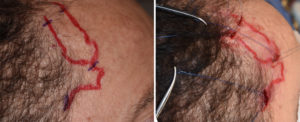The superficial temporal artery (STA) is a branch of the facial artery that crosses in front of the ear and heads northward into the scalp. At a fairly predictable point above the ear it turns into a Y configuration with an anterior branches coursing across the forehead at it turns up into the scalp. It has a very snake-like course along this pattern much like many rivers going through a valley. It is not precisely known why it has this very irregular course when a straighter line would presumably suffice but there is undoubtably some developmental purpose to it.
For reasons that are equally unclear as that of its sinuous course, in some people the course of the artery becomes very apparent due to vessel dilatation. This appears to be almost exclusively in men which I assume is due to their large muscle component of the arterial walls. When exposed to any agent that causes the artery to experience increased flow, such as heat, exercise and alcohol being the common offenders, it bulges out like a thick rope producing a unique and unaesthetic feature of the temples and forehead. In men with hair the dilated artery and its dicta branches are only seen beyond the hairline. But in men who shave their heads or with very short hair, the course of the abnormal vessel may be seen all up along the ear and into the forehead.
The surgical treatment for a prominent STA is ligation. While it is tempting to do so only in a most proximal location, this approach should be avoided. While I have seen cases of that being done and the patient reports some reduction in its prominence, it is not usually completely successful strategy. This is because, while all veins have valves, few arteries do. This allows the high potential for backflow coming across the scalp and back down into the distal portion of the arterial system allowing the vessel to remain prominent. This serves as the basis for a multipoint ligation approach.

What this temporal artery ligations approach, the success rate is higher with a much lower revision rate. There have been no instances of facial nerve injury or scalp hair loss issues.
Dr. Barry Eppley
Indianapolis, Indiana


